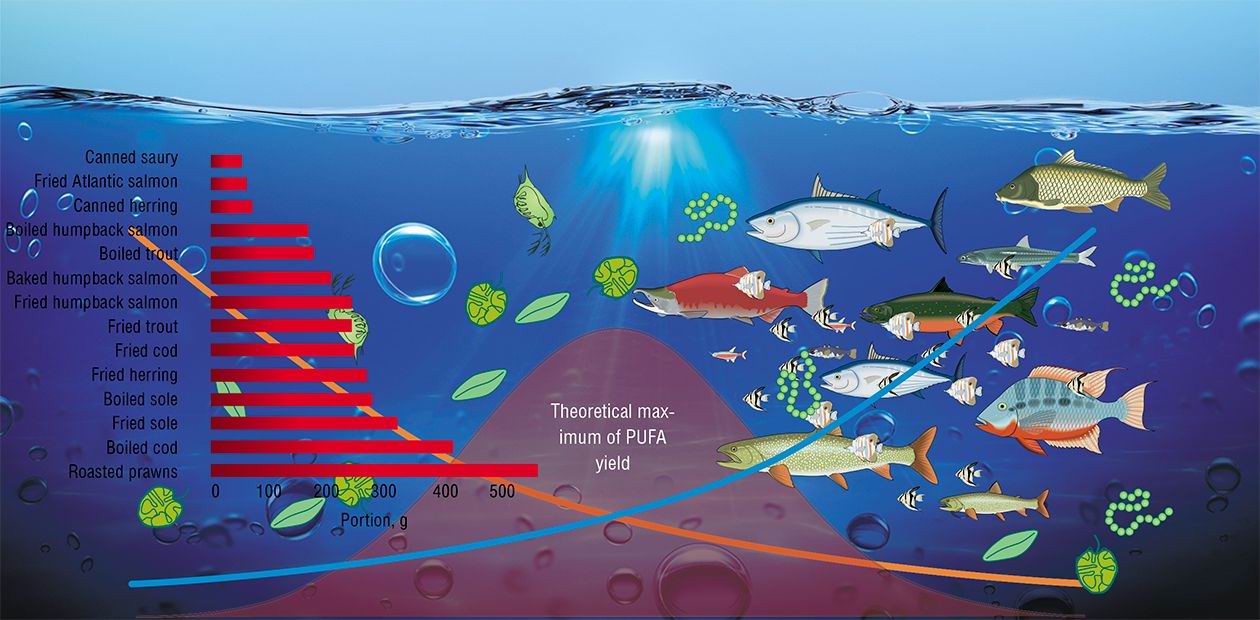Fats to the Mind and Heart
The contemporary nutritional science started up within physiology and biochemistry as early as almost two centuries ago. A century later, it was found out that besides to the major nutrients the food should obligatory contain vitamins, the substances with rather a simple structure performing either a catalytic or an informational function. These compounds of a diverse chemical nature have two features in common: first, they are demanded in very small quantities as compared with proteins or carbohydrates and, second, most of these substances are not produced in the human body. In the early 20th century, the set of known vitamins was supplemented with special fatty acids essential for a normal function of the animal brain as well as their nervous and cardiovascular systems. The main source of such fat undoubtedly useful and literally indispensable for humans is fish and other products of aquatic ecosystems
The contemporary nutritional science started up within physiology and biochemistry as early as almost two centuries ago. A century later, it was found out that besides to the major nutrients the food should obligatory contain vitamins, the substances with rather a simple structure performing either a catalytic or an informational function. These compounds of a diverse chemical nature have two features in common: first, they are demanded in very small quantities as compared with proteins or carbohydrates and, second, most of these substances are not produced in the human body.
In the early 20th century, the set of known vitamins was supplemented with special fatty acids essential for a normal function of the animal brain as well as their nervous and cardiovascular systems. The main source of such fat undoubtedly useful and literally indispensable for humans is fish and other products of aquatic ecosystems
The organic substances entering our body with food fall into three major groups—proteins, carbohydrates, and fats (lipids). The major part of fats is the so-called fatty acids, the molecules of which consist of carbon chains with a carboxyl group (COOH) on the one end and a methyl group (CH3) on the other. Individual fatty acids differ from each other not only in the number of carbon atoms, but also in the type of chemical bond between them: the adjacent atoms can be linked via an ordinary chemical bond (C–C) or a double bond (C=C). The larger the number of such double bonds in a molecule, the more twisted is the carbon chain, approaching a helix in its shape. Noteworthy that the spatial structure of fatty acid molecules in many respects determines their biochemical properties.
The fatty acids lacking any double bonds are referred to as saturated fatty acids and those with double bonds, as unsaturated ones. The acids containing two or more double bonds have got a special name, polyunsaturated fatty acids (PUFAs).
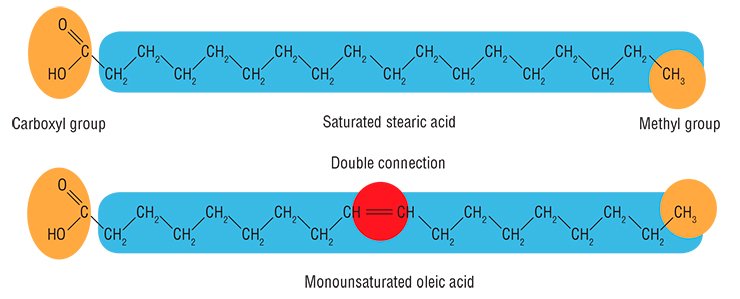
It has been found already 70 years ago that any normal animal growth and development are impossible without polyunsaturated fatty acids as well as that such compounds may be with a good reason ascribed to vitamins (from the Latin word vita for life). Their totality was designated as vitamin F (from fat), since a special role of individual acids was unknown at that time.
OMEGA IS NEITHER LAST NOR LEAST LETTER IN CLASSIFICATION Fatty acids have complex chemical names as well as simple and short designations. According to the currently used classification, the first part of such designations indicates the length of the carbon chain followed by the number of double bonds separated by colon (in this case, the number of carbon atom from which this bond starts is indicated counting from the methyl end of the molecule is given at the end).For example, stearic acid, comprising 18 carbon atoms and lacking any double bond, is designated 18 : 0, while oleic acid, having the carbon chain of the same length and one double bond, 18 : 1n-9. If a molecule contains several double bonds, position of the first one is indicated.
In addition, the number of carbon atom forming the first double bond is traditionally designated with the Greek letter ω (omega) in many papers, especially those on healthy nutrition. According to this classification, oleic acid is referred to as omega-9 fatty acid
The biochemical mechanisms underlying the action of different PUFAs in human body were discovered less than 40 years ago. And only the mid-1990s brought the methods allowing for reliable identification of PUFAs in biological objects, that is, the techniques providing for distinguishing between individual fatty acids in their mixture. This stimulated a new round of the research into physiological role and natural sources of these fatty vitamins.
There are irreplaceable things!
Double bonds are formed in fatty acid molecules owing to the activity of specialized enzymes, desaturases, each of which being able to form an unsaturated bond only in a strictly defined region of the carbon chain. The presence or absence of particular desaturases in an organism is determined by the genotype. Note that unlike algae and higher plants, the overwhelming majority of invertebrate species and all the vertebrates, human included, lack the enzymes able to “attach” a double bond to the third and sixth atoms of the carbon chain, counted from the methyl end of the molecule. In other words, all these animal organisms are unable to synthesize omega-3 and omega-6 polyunsaturated fatty acids.
These PUFAs so necessary for the vital activities of animals and humans but not synthesized in their bodies have been named essential. They include the 18-carbon fatty acids referred to as linoleic (carrying two double bonds) and alpha-linolenic (with three double bonds) acids.
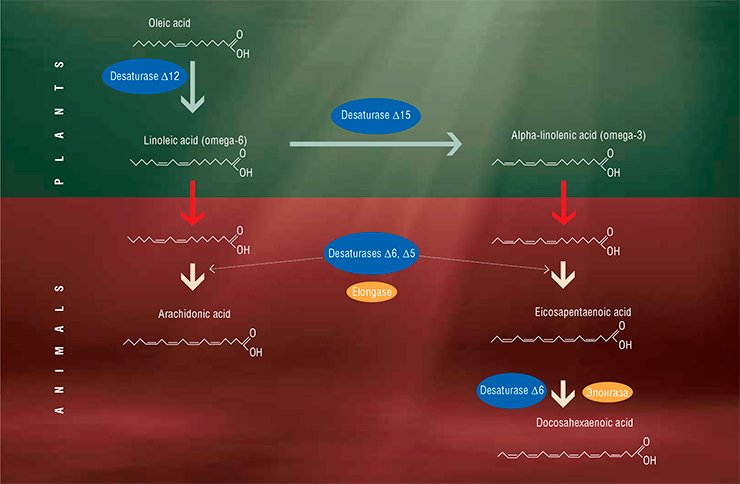
According to the recent data, up to 70% of the essential fatty acids received with food are “burned up” during the first 24 h along with a common fat to provide for energy demands of the body (Broadhurst et al., 2002). Some researchers believe that part of fatty acids may also accumulate in the skin, protecting it from excess loss of water and enhancing its peeling, which decreases surplus pigmentation induced by ultraviolet radiation (Sinclair et al., 2002).
However, the main role of essential fatty acids is in that they are biochemical precursors of physiologically significant long-chain PUFAs, the molecules of which comprise 20 to 22 carbon atoms, namely, omega-6 arachidonic acid (four double bonds), omega-3 eicosapentaenoic acid (five double bonds), and omega-3 docosahexaenoic acid (six double bonds).
Such long-chain PUFAs are referred to as partially essential, since animals and humans are able to synthesize them of essential fatty acids obtained from food. However, the efficiency of such synthesis is low enough, although these particular compounds are the most important players in maintaining an adequate function of many body systems.
The fruits of competition
Along with other fatty acids, partially essential long-chain PUFAs are a component of the cell membranes, a major structure–function element of the living cell, housing most processes associated with transformation of matter and energy.
The cell membranes are a phospholipid bilayer with various proteins embedded into it. The phospholipids typically consist of a hydrophilic (water soluble) “head”, phosphatidic acid, and two hydrophobic (water insoluble) “tails”, one of which is most frequently represented by a saturated fatty acid (for example, stearic acid) and the other, by obligatory unsaturated one.
The fatty acid composition of cell phospholipids in different organs and tissues is considerably different: as a rule, the more complex the function of an organ, the higher is the concentration of long-chain PUFAs in it. In particular, the concentration of docosahexaenoic acid in human body reaches its maximum in the eye retina versus its several tenfold lower content in a common fatty tissue, composed of storage fats (triglycerides) rather than phospholipids.
The most important physiological and biochemical role of the other two long-chain PUFAs consists in that they are biochemical precursors of eicosanoids, a vast group of physiologically active compounds. In the type of their action, these substances are endohormones, that is, they manifest their activity in the very tissues where they are synthesized.
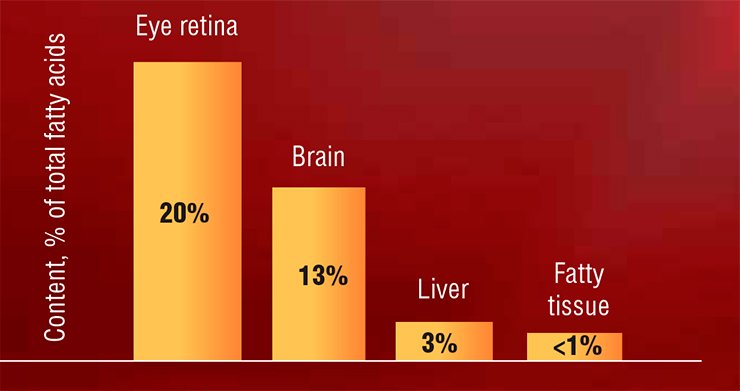
The synthesis of endohormones starts with PUFA release from the cell membrane phospholipids caused by specialized enzyme. Then other enzymes synthesize several active substances of them, namely, prostaglandins, thromboxanes, and leukotrienes. Amazing it may seem but the same (!) enzymes catalyze the syntheses of endohormones displaying absolutely opposite effects on the body.
In particular, the endohormones synthesized of arachidonic acid cause constriction of blood vessels and enhance aggregation (agglutination) of platelets, leading to an increase in arterial blood pressure, clotting, and embolism. Other derivatives of arachidonic acid trigger an inflammatory process, cause bronchospasms, and secretion of mucus. As for the eicosapentaenoic acid derivatives, they, on the contrary, decrease arterial blood pressure, have an anti-inflammatory effect, and dilate bronchi, being anti-allergens (Simopoulos, 2000; Wall et al., 2010).
Thus, excess arachidonic acid in cell phospholipids leads to development of dangerous diseases, first and foremost, cardiovascular ones, as well as to inflammations, edemas, pains, and allergies. Indeed, there are a number of drugs against these diseases: in particular, the well-known aspirin blocks the enzyme cyclooxygenase, involved in one of the stages in synthesis of endohormones from arachidonic acid. However, there is another more appealing and safe method.
It is possible to avoid all the above mentioned troubles if the membrane phospholipids will contain a sufficiently high concentration of eicosapentaenoic acid, a “competitor” of arachidonic acid for enzymes. In this case, a certain balance of endohormones—derivatives of both fatty acids—will be maintained in the body. Then, pain and inflammation will not kill but heal.
Note that docosahexaenoic acid can be also transformed into an endohormone, neuroprotectin D. Its role is clear from its name—protection of nerve cells from the impact of adverse factors, for example, oxidative stress.
Does one have to be born a vegetarian?
Alpha-linolenic acid is the major fatty acid in the photosynthesizing membranes of chloroplasts, the “accumulators” of solar energy. Therefore, this acid itself is extremely important for plants; however, it is mentioned above that alpha-linolenic acid in the animal organisms does not play an independent role but serves as a precursor for physiologically significant long-chain fatty acids.
Note also that the demand of herbivorous animals for such PUFAs is likely to be completely satisfied by their synthesis from alpha-linolenic acid, which enters their body with the consumed green plants.
However, the majority of omnivorous animals and predators, human included, require a direct consumption of long-chain PUFAs. For example, it is considered that only 10% of the alpha-linolenic acid consumed by a person can be converted into eicosapentaenoic acid and only 5%, into docosahexaenoic acid (Davis and Kris-Etherton, 2003; Wall et al., 2010). A great value of these fatty acids to the body is confirmed by the fact that less than 5% of the “ready-to-use” docosahexaenoic acid obtained from food are “burned” in mitochondria, while the remaining part is utilized for construction of the cell membranes (Plourde and Cunnane, 2007).
Therefore, most people with an average genotype require a regular consumption with food of long-chain PUFAs in a considerable quantity but with the only exception of vegetarians. The contents of eicosapentaenoic and docosahexaenoic acids in the blood of vegetarians are by 20–30% lower as compared with “omnivorous” people and yet they lack any evident clinical symptoms of PUFA deficiency (Davis and Kris-Etherton, 2003).

The causes underlying such specific organismal features of vegetarians are still unclear; however, it is likely that these acids in the case of vegetarians should be more efficiently synthesized and more carefully spent (Plourde and Cunnane, 2007). There is no wonder in such a phenomenon, since the differences in the operation of enzyme systems in individuals with different genotypes are now well known. Presumably, such a genetically determined way of regulation provides for the body function of vegetarians.
In addition, the plant food they consume supplies them with a comparatively large amount of alpha-linolenic acid, the initial compound for synthesis of long-chain omega-3 PUFAs. On the other hand, eating no meat, they do not receive “ready-to-use” omega-6 arachidonic acid, which competes with eicosapentaenoic acid for the enzymes synthesizing endohormones.
The healthy heart of eskimos
Once the mechanisms of action were clarified, the period of mass clinical and epidemiological (population) studies began. First and foremost, scientists and medical researchers were interested in the correlation between the PUFA content in the blood plasma and development of cardiovascular diseases. In the second half of the 20th century, the cardiovascular mortality in industrially developed countries displayed a threatening growth. For example, the annual mortality of the diseases affecting the blood circulation system in Russia in 1995–2009 was about 1.2 million cases versus 300 thousand persons that died of cancer, accidents, and violence (Popov, 2012).
Just note that as early as the mid-1970s, it was known that the Greenland Eskimos, almost not affected by cardiovascular diseases, displayed considerably less content of omega-6 PUFAs and considerably higher content of omega-3 ones in their blood plasma as compared with the Western Europeans. As for the cholesterol content, earlier regarded as the major risk factor, it was almost the same.
Further studies have mainly covered North America and Western European countries and involved large population cohorts, to 10,000 and more people. These studies have demonstrated that an increased consumption of omega-3 PUFAs decreases the risk of cardiovascular diseases in healthy persons in a statistically significant manner (almost tenfold!) as well as enhances recovery and decreases the mortality rate among the ill people by one-third (Harris et al., 2009).
A special parameter, the omega-3 index, is used to assess the risk for cardiovascular diseases; this index reflects the share of long-chain polyunsaturated fatty acids in the total fatty acids in erythrocytes (red blood cells). The risk of cardiovascular diseases for the persons with an omega-3 index < 4% is tenfold higher as compared with those with the index exceeding 8% (Saldanha et al., 2009).Evidently, the mechanism of such a beneficial effect of eicosapentaenoic acid on the function of blood circulation system consists in an increased synthesis of endohormones, which influence the blood vessels as well as clotting and inflammatory processes (Plourde and Cunnane, 2007; Phang et al., 2011). As for docosahexaenoic acid, it provides for an efficient signal transduction in nerve cells, preventing development of arrhythmia and cardiovascular spasms, while its high level in the mitochondrial membranes of myocardial cells elevates the efficiency of energy production and use in our “motor” (SanGiovanni and Chew, 2005).
Which of these mechanisms is the leading one is still unclear, but the very fact that the long-chain omega-3 PUFAs are indispensible for maintenance of the healthy cardiovascular system is doubtless. One more characteristic has emerged to be associated with the cardiovascular mortality rate, namely, the balance between omega-6 and omega-3 acids. The higher this ratio, the higher is the mortality rate.
Lunch on prescription
As is already mentioned, the levels of various PUFAs in the human blood and other organs and tissues are determined by the diet. That is why the World Health Organization and several national medical agencies recommend taking 500–1000 mg of omega-3 polyunsaturated fatty acids on a daily basis for prevention of cardiovascular diseases. Note that the omega-6 to omega-3 PUFA ratio should not exceed 3 : 1 (ideally, 1 : 1).
What are the recommendations of nutritionists for this situation? From the standpoint of nutrition, of the widely used plant oils, olive oil displays the most favorable fatty acid ratio. However, it is currently ousted from the market by a cheaper product, sunflower oil, which in the recent decade takes place even in Mediterranean countries, such as Spain and Portugal. However, sunflower oil almost lacks omega-3 alpha-linolenic acid (Rodriguez-Carpena et al., 2012).
Characteristic of wheat grain is an adversely high fatty acid ratio; the same is true for chicken meat and eggs, especially when fed grain (Simopoulos, 2000; Rule et al., 2002; Suchowilska et al., 2009).
As for the animal meat, especially mutton and beef, their fatty acid ratio is almost ideal, being small enough even in pork (Wood et al., 2008). However, if meat is fried in sunflower oil (as they usually to do when cooking hamburgers), the omega-6 to omega-3 ratio drastically increases (Rodriguez-Carpena et al., 2012).
Green vegetables, such as various kinds of cabbage and lettuce, are especially rich in alpha-linolenic acid (Batista et al., 2011). However, fish is the major product with a high concentration of long-chain PUFAs, especially most valuable omega-3 acids. This is why it is no surprise that nutritionists recommend eating more green vegetables and fish in order to attain a favorable ratio of the essential fatty acids in the diet. The animal meat per se is not a dangerous product but one should pay special attention on how it is cooked.
Such recommendations are of special value for the current communities of the so-called western type, that is, for population of most of the industrially developed counties, where the consumption of omega-6 acids is 15–20-fold larger as compared with omega-3 acids. Such a situation in many respects has resulted from streamlining of agriculture in the second half of the 20th century and consequent predominance in the diet of the meat products grown on grain feed, with their high content of omega-6 PUFAs (Simopoulos, 2000; Wall et al., 2010).
This trend is currently retained. Thus, the consumption of linoleic acid, say, in Europe over the last 20 years has grown 1.5-fold, being accompanied by an increase in the rate of cardiovascular diseases (Wall et al., 2010).
Aquatic storerooms
Why are fish and other sea dwellers—crabs, mollusks, prawns, and so on—so rich in the fatty acids essential for us? The fact is that the terrestrial higher (flowering) plants stop their synthesis at 18-carbon alpha-linolenic acid. Of all the known organisms, only some microalgae are able to efficiently synthesize eicosapentaenoic and docosahexaenoic acids and accumulate them in large amounts.
That is why aquatic ecosystems are the major natural reservoirs and suppliers of long-chain omega-3 PUFAs, which are conveyed via the food chain to aquatic invertebrates through fish to eventually reach land animals.
Three questions arise in this connection. First, how do the land animals incapable of fishing still succeed in obtaining the essential PUFAs?
Second, according to the rule of ecological pyramid, biomass of the organisms of each trophic level amounts to approximately one-tenth of the previous layer. This means that at least 90% of the organic substance, essential fatty acids included, transferred between two components of the food chain (for example, from herbivores to predators) should “dissipate”. What will be the losses of PUFAs in this case?
Finally, are the amounts of the PUFAs synthesized in aquatic ecosystems sufficient to provide all the land animas (and humans) in need?
We will try to answer these questions. The land animals unable to fish can obtain PUFAs from aquatic ecosystems by two ways. The first flow is formed by the semiaquatic birds, which feed on algae, small invertebrates, and the very fish. Adult birds, their eggs, and nestlings become preys of land predators. According to calculations, slightly less than half million tons of long-chain omega-3 PUFAs are annually exported to land by semiaquatic birds (Gladyshev et al., 2009). For comparison, the corresponding “yield” of all the bears hunting the Pacific salmons running for spawning is 200-fold smaller!
The other significant flow of omega-3 long-chain PUFAs from aquatic ecosystems to land is provided for by the flying amphibiontic insects, whose larvae and pupae live in aquatic medium. This group includes dragonflies, black flies, caddisflies, blood-sucking mosquitoes, midges, and so on. Their larvae feed on algae and other small aquatic organisms and pupate; then an adult insect emerges from pupa, and its adult body has a good reserve of the products synthesized by microalgae. Thus, approximately quarter million tons of long-chain omega-3 PUFAs are annually taken ashore (Gladyshev et al., 2009).
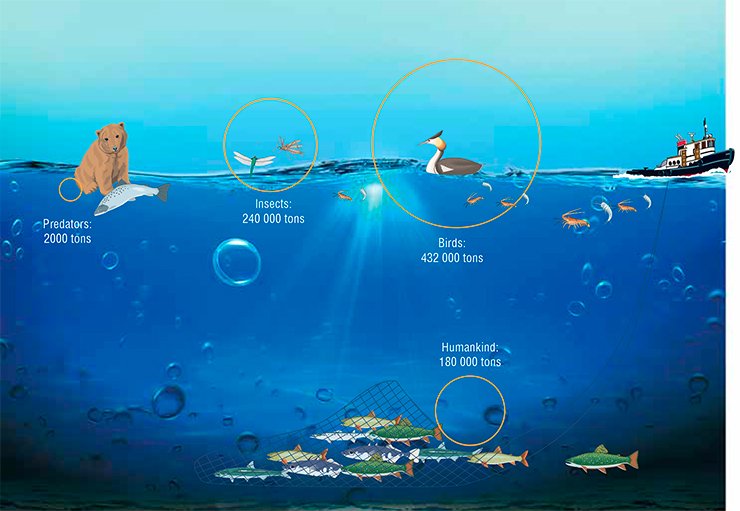
Another amazing fact: the contribution of the World Ocean, immense in its area, to the total PUFA flow from water to land has emerged to be 25-fold smaller as compared with the continental water bodies, lakes, and rivers! The explanation is simple enough: the key factor in this case is the length of the shore line, that is, the length of the water–land interface, rather than the area. The global length of the ocean coastline is slightly more than 500,000 km versus 35 million kilometers of the total shore line of a multitude of small and large lakes, that is, almost 60-fold longer! However, this refers only to the natural communities, since humans with their modern tools harvest the major part of PUFAs from the ocean (Gladyshev et al., 2009).
As for the issue of PUFA losses in the food chain, the answer was obtained only several years ago. Researchers from the Institute of Biophysics (Siberian Branch, Russian Academy of Sciences, Krasnoyarsk, Russia) in their studies at a small artificial reservoir estimated the efficiency of organic substance transfer, which appeared close to the classic value being slightly larger than 6%. It has emerged in these studies that 16-carbon PUFAs are excellent “fuel” for cells, almost 95% of which are “burned” in the mitochondria, while the transfer efficiency of omega-3 PUFAs is about 13%, that is, twice higher. Thus, it has been proved that the long-chain polyunsaturated fatty acids produced by microalgae accumulate in the biomass of the organisms forming the upper trophic levels, for example, in fish (Gladyshev et al., 2011).
Interestingly, an analogous effect is observable at the level of organism. In particular, the brain cells of humans and other animals selectively take up docosahexaenoic acid from the blood and accumulate it (Bazan, 2009). The transfer efficiency of this fatty acid to the fetus is also considerably higher as compared with other acids (Lauritzen et al., 2001). Docosahexaenoic acid also accumulates in the fish roe at the expense of its decrease in the muscle tissue (Sushchik et al., 2007).
Enough for all?
Different climatic zones and landscapes house different aquatic and terrestrial ecosystems; correspondingly, the ratio of PUFA production to demand may differ as well. However, average biospheric values allow for approximate estimations.
In particular, it is possible to use for such calculations the estimation for PUFA flow from continental water bodies ashore and as a model object, the omnivorous rodents, the biomass of which in terrestrial ecosystems exceeds several tenfold that of the large predators. In this case, the annual export of omega-3 PUFAs to terrestrial ecosystems is 2.5–11.8 kg/km2 versus the demand of 6.5 kg/km2 (Gladyshev et al., 2009). Thus, the fatty acid production is on the average sufficient to satisfy the needs of even the most active and numerous land animals. However, note that its value can be in some cases even lower than the “living wages”, the more so since not all of it is available for consumption.
As for humans, the data for the world catch of fish and invertebrates make it possible to assess that approximately 180 tons of long-chain omega-3 PUFAs are annually “extracted” from aquatic ecosystems.
According to the UN data, the average annual consumption of fish and seafood is 16 kg with the content of essential omega-3 acids amounting to 20 g/kg. Apparently, the average daily consumption of these vitally important compounds does not exceed 0.1 g. Alas, the dose recommended for prevention of cardiovascular diseases is tenfold higher (Kris-Etherton et al., 2002, 2009; Reis and Hibbeln, 2006; Harris et al., 2009)!
This leads to a deplorable inference: mankind experiences large deficit in physiologically important long-chain omega-3 PUFAs, which contributes to an extremely high mortality rate of vascular diseases. This is especially important challenge for Russia, where the annual fish consumption during the last decade is no more than 13 kg per person.
Where’s it come from?
Thus, according to medical prescriptions, mankind needs to elevate severalfold the consumption of long-chain PUFAs. However, the expert estimations state that the annual fish catch on a global scale has reached its maximum limit of 100 million tons and cannot be further increased (Pauly et al., 2002).
The evident solution suggests itself: it is necessary to develop aquaculture, that is, farming of fish and aquatic invertebrates. Indeed, this branch is rapidly developing in many countries worldwide; according to some estimates, its yield is currently equal to half world catches. Unfortunately, the share of Russia in the world aquaculture is depressingly small, amounting to only 0.1 million tons annually.
Yet there are two objective factors that prevent an excessive growth in aquaculture. First, this is a negative impact on wildlife ecosystems, since aquaculture is a source of considerable organic and biological pollution for water bodies, where “feral” fish fatten and is caught (only pond farming causes no damage to natural water bodies).
Second, high-yield aquaculture requires the feeds rich in essential PUFAs, which are essential for fish growth and development, similar to most of other animals. Such feeds are produced of the invertebrates and fish caught in wildlife ecosystems. Thus, for example, in Norway, the fish biomass utilized for rearing the Atlantic salmon is larger than the produced biomass (Pauly et al., 2002).
Currently, they attempt to break the vicious circle and start producing the necessary PUFAs beyond natural water bodies. This means an industrial cultivation of microalgae as well as raising genetically modified higher plants carrying the corresponding genes of microorganisms, algae, or bacteria (Damude and Kinney, 2007).
However, the economical prospects of such efforts are still vague and a full-fledged balanced feed is yet one of the most expensive components in aquaculture. Correspondingly, the price for the reared fish is frequently beyond the means of common consumers.
Evidently, the natural water bodies will remain the main source of fish for humans even in the case of the most successful advance in aquaculture. Hydrobiology is the field of science involved in assessing the production potential of natural water bodies and establishing the scientific background for their rational use. In its frame, the approaches have been elaborated that allow the production supply at various trophic levels from microalgae to fish to be estimated and the permissible volume of biomass that can be harvested without any damage for individual aquatic systems to be determined (Alimov, 1989).
Currently, the knowledge about the quality of harvested fish products, that is, about the content of long-chain omega-3 PUFAs, acquires an ever increasing importance. The beliefs in high value of particular fish species (that the red salmon is the most valuable fish) appeared long before the advent of chromato-mass spectrometers; however, they amazingly coincide with the modern estimates based on the content of long-chain omega-3 PUFAs in their meat, which may differ more than 40-fold.
It is evident that replacement of one fish species with some other either in aquaculture or in fish catches can significantly change the amount of harvested PUFAs in the same biomass. This demonstrates a topical character of examining the aquatic bodies with respect not only to their productivity level, but also to their ability to produce a particular amount of long-chain omega-3 PUFAs.
Awaiting no gifts from nature
Several years ago, researchers from the Siberian Branch of the Russian Academy of Sciences in collaboration with their colleagues from other Russian regions and foreign scientists started cataloguing the natural water bodies in the Yenisei, Ob, Volga, and Dnepr River basins as well as in Belarus, Kamchatka, Bol’shezemel’skaya Tundra, and southern Illinois (United States). It was necessary to find out what types of ecosystems can give the maximum yield of valuable PUFAs.
As is known, natural water bodies considerably differ in both biodiversity and level of organic substance production. For example, the main species in the so-called oligotrophic (low nutrient content) lakes and rivers with a low temperature and clear transparent water are diatomic algae. They are capable of synthesizing long-chain omega-3 PUFAs; however, the overall photosynthetic production is rather low, since the water of these lakes is poor in mineral elements. Salmonids, displaying a very high content of essential PUFAs, live in oligotrophic waters, but their catches are rather small.
Warm and turbid waters of the eutrophic lakes, rich in organic substances, predominantly house green algae and cyanobacteria (green-blue algae). Characteristic of them is a very high level of primary production; however, they are unable to synthesize long-chain omega-3 PUFAs. Cyprinid fish species actively grow and reproduce in this rich forage reserve; however, the content of the fatty acids that we need in their bodies is low.
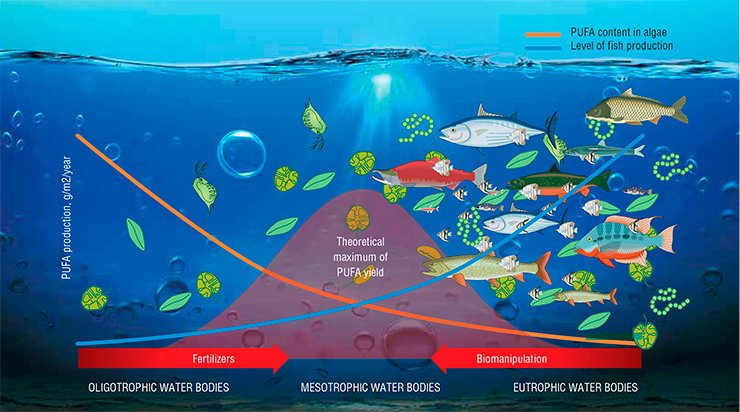
There is an intermediate variant—the so-called mesotrophic water bodies with a medium content of nutrients. To determine which of the listed variants is the most advantageous for humans in the perspective of gaining the maximum yield of essential PUFAs is quite a new scientific challenge.
How is it possible to elevate the production of PUFAs in aquatic ecosystems? In the case of seas, this is attainable exclusively by optimizing the total catch and preventing pollution. As for the inland water bodies, there are some additional possibilities. In particular, oligotrophic water bodies can be fertilized by supplementing them with the mineral elements required for plant nutrition (phosphorus and nitrogen) in strictly specified amounts. Such experiments are in progress in Canada (Hyatt et al., 2004) and Sweden (Persson et al., 2008) and show promise.
The eutrophic water bodies, with their typical water “blooming” caused by cyanobacteria, can be cleaned from these algae by biomanipulation. Its essence is in a deliberate alteration of the trophic structure of a water body, namely, via an increase in the number of predatory fish of a “high trophic level” and the corresponding decrease in the number of their prey, the fish feeding on zooplankton. This will lead to an elevation in the population of invertebrate plankton, which in turn will actively eat “surplus” microalgae, thereby arresting the water “blooming.”
In Russia, such a biomanipulation was for the first time implemented by researchers from the Institute of Biophysics in 2002–2003 in a small artificial reservoir, Bugach, located in the neighborhood of Krasnoyarsk (Gladyshev et al., 2003, 2006).
Another way to increase the quality of fish products is stocking a water body with valuable fish species. In particular, the peled, which also belongs to salmonids, has been for many years released into the lakes of southern Khakassia, earlier almost fishless. A promising variant of an increase in the PUFA production is also stocking water bodies with herbivorous fish species (silver or grass carp), which form a short food chain, feeding directly on algae or higher aquatic plants.
Essential “antifreeze”
Currently, the risks for a decrease in PUFA production in natural water bodies are mainly associated with global climate warming and anthropogenic pollution.
The first factor, that is, an increase in water temperature, directly influences the level of production. The fact is that the algal cells for their normal function require maintenance of an optimal cell membrane viscosity. Therefore, the species adapted to low temperatures contain many polyunsaturated fatty acids, characteristic of which is a low freezing temperature. The lower the ambient temperature, the higher will be the content of such “antifreeze agents” (Guschina and Harwood, 2009).
At high temperatures, algae, on the contrary, have to synthesize saturated fatty acids with a high melting temperature. That is why, for example, diatomic algae, containing large amounts of eicosapentaenoic acid, are prevalent in colder water, while warmer waters are more advantageous for green and blue-green algae, unable in principle to synthesize long-chain PUFAs (Sushchik et al., 2004).
A similar phenomenon is observed for invertebrates: the species rich in PUFAs are replaced by some other species with a change in temperature conditions. For example, the PUFA reserve in zooplankton in Belarusian lakes, which are warmer as compared with the water bodies of Bol’shezemel’skaya Tundra, Siberia, and Kamchatka, is decreased owing to replacement of copepods by cladocerans, displaying lower content of docosahexaenoic acid (Gladyshev et al., 2011). Both crustaceans are the major component in the diet of juvenile fish; that is why the change in the nutritive base automatically leads to a decrease in the quality and quantity of fish products (Copeman et al., 2002; Caramujo et al., 2008; Vizcaino-Ochoa et al., 2010).
As for the fish, climate warming causes replacement of salmonids in European lakes by perch-like fish species and, in turn, replacement of the latter by cyprinids (Jeppesen et al., 2010). In this row, the PUFA content in fish meat also considerably decreases.
Recently, anthropogenic eutrophizing is becoming an ever more important factor; this is associated with pollution with excess mineral elements, nitrogen and phosphorus, brought by wastewaters and inducing explosive development of blue-green algae. In addition, other organic substances and heavy metals are discharged into water bodies. It has been shown that such anthropogenic pollution of the Yenisei River decreases the PUFA transfer efficiency along the food chain, although the algal production remains at the same level or even increases (Gladyshev et al., 2012).
Note another crucial point: heavy metals can accumulate in the upper elements of the food chain, that is, in fish. Thus, when eating fish in the amount recommended by nutritionists, a person risks concurrently receiving rather a large dose of heavy metals or pesticides. It is evident, therefore, that the fish products should be constantly assayed for the presence of not only useful nutrients, but also toxic substances (Gladyshev et al., 2009).
Food zoology
The contents of valuable PUFAs in the meat of many fish species and marine invertebrates of our menu have been determined.
Marine pelagic fish, living in the surface waters, have the highest nutritive value. The food chains that they top are based on diatomic and peridinium algae, which synthesize long-chain omega-3 PUFAs in large quantities, as well as on the above-mentioned copepods, feeding on these microalgae. The pelagic fish include the herring, sardine, and capelin, feeding on zooplankton, as well as large salmonid species (Atlantic, humpback, and red salmons), eating small pelagic fish.
Marine bottom-dwelling fish (e.g., sole), similar to many freshwater fish species, contain relatively small amounts of valuable PUFAs. Some researchers believe that the freshwater fish cannot serve as a significant source of long-chain omega-3 PUFAs for humans at all (Philibert et al., 2006). However, such an opinion in many respects is based on insufficient knowledge about the PUFA content in the species inhabiting inland water bodies.
The truth is that the PUFA content in most studies is assessed in an indirect manner: the amount of PUFAs is expressed as percentage of the total fatty acids, while the concentration per unit weight of the product remains unknown. Moreover, mass spectrometry assays should be used to reliably distinguish the fatty acids of physiological and biochemical value, which practically is very rarely used. Therefore, we can positively state that the freshwater whitefish species feeding on planktonic copepods, such as omul, peled, and vendace, are likely to have high enough content of long-chain omega-3 PUFAs.
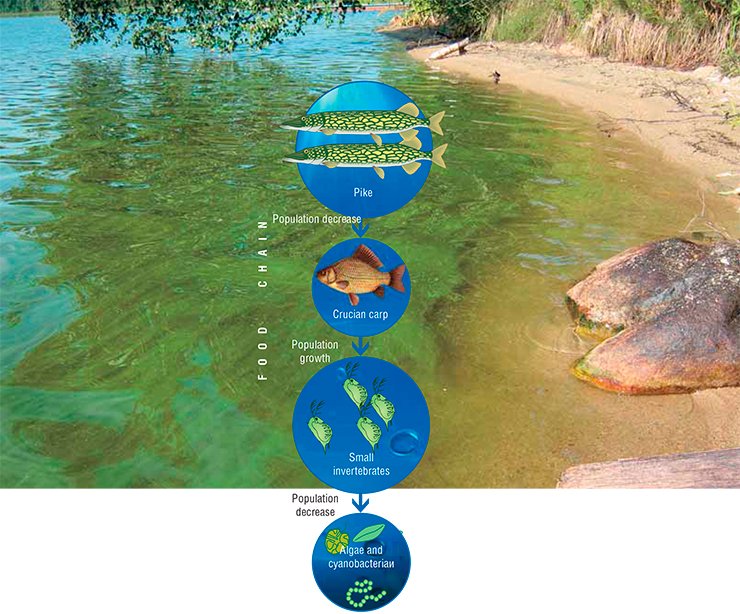
However, all this refers to only raw fish, which is rarely eaten in the majority of countries. So, how does cooking influences the PUFA content in fish? It is known that polyunsaturated fatty acids are unstable to oxidation and heating. That is why is has been long believed that cooking “breaks” the double bonds in PUFAs so that they lose their unique useful properties.
Indeed, a chemically pure PUFA degrades when heated. However, it has been just discovered that the contents of long-chain omega-3 PUFAs in fried, boiled, and roasted fish do not decrease as compared to the raw fish. These data were published in 2006–2007 in Food Chemistry, one of the most reputable international journals in the field of food chemistry (Gladyshev et al., 2006, 2007). The main reason underlying this phenomenon is the fact that fish contains these fatty acids within the cell membrane phospholipids rather that in a pure form; there, the PUFAs are densely packed in bilayers being encompassed by proteins. Presumably, such a “wrapping” prevents them from degradation during cooking.
HAD FISH MADE A MAN FROM AN APE? The concept of a unique role of fish diet in the evolution and establishment of Homo sapiens (Crawford et al., 1999; Broadhurst et al., 2002; Muskiet et al., 2004) is becoming ever more popular. This theory is primarily based on the fact of a large size (relative to the body) of the human brain.The dry substance of mammalian brain contains 60% of lipids, with fatty acids accounting for one third of them and docosahexaenoic acid as the main (to 20%) contributor (Lauritzen et al., 2001; Broadhurst et al., 2002; McNamara and Carlson, 2006). This particular acid is the major fatty acid in the cell membranes of the cortical gray substance. The content of docosahexaenoic acid is almost the same in the brain of all mammalian species; however, the encephalization quotient – deviation of the actual brain size from the ratio calculated for a “standard” species – of Homo sapience is considerably higher as compared with Australopithecus and apes to say nothing about other mammals (Roth and Dicke, 2005). Taking into account that docosahexaenoic acid is almost not synthesized in the brain itself, the human body has to supply the brain with this acid much more intensively as compared with the other “brainy” animals.
The brain cells as well as the cells of the nervous system and visual organs are able to selectively take up docosahexaenoic acid from the blood and retain its “caught” amounts for extremely long time, maintaining its constant concentration. For example, it is possible to achieve a decrease in the concentration of this acid in the brain and retina in rodents only applying a special diet for a couple of generations (Bazan, 2009). Nonetheless, 2–8% of the contained docosahexaenoic acid is daily spent in the human brain as a result of metabolism and this stock should be restored (McNamara and Carlson, 2006).
In the prenatal development, the human embryo receives docosahexaenoic from the mother’s body; note that the rate of its transplacental transfer is threefold higher as compared with the arachidonic acid (Lauritzen et al., 2001). This intensive and selective transfer leads to a twofold decrease in the content of docosahexaenoic acid in the maternal blood plasma (Broadhurst et al., 2002). We have also discovered a similar phenomenon in fish (Sushchik et al., 2007). During breastfeeding, the stock of docosahexaenoic acid in mother’s body is also depleted by its conveyance to the breast milk (Lauritzen et al., 2001).
A deficiency of this PUFA in mother’s and child’s diets leads to a decreased learning capacity of children as well as visual activity and development of psychomotor functions. Such a deficiency in adults is accompanied by the risk of depression, schizophrenia, aggression, mental disability, and other nervous disorders, including Alzheimer’s disease. To prevent such disorders, the American Psychiatric Association recommends daily consumption of 1 g of omega-3 PUFAs (Reis and Hibbeln, 2006) – this dose is also recommended for prevention of cardiovascular diseases (Kris-Etherton et al., 2002, 2009; Reis and Hibbeln, 2006; Harris et al., 2009).
The only product with a high content of docosahexaenoic acid is fish and other aquatic organisms. Turning back to the issue of human evolution, note that, as is known, the prehistoric man usually settled on the shores of rivers, lakes, and seas. Certainly, manifold factors enhanced this but we cannot exclude that a major factor was access to food, especially that rich in docosahexaenoic acid. The fish remaining ashore in the so-called tidal pools as well as mollusks and turtles could become a relatively easy prey even for unarmed people, including women and children, the cohorts that most of all demand such food (Gibbons, 2002).
The use of seafood in the “diet” of Stone Age folks has its archaeological confirmations. For example, up to 20 m thick fossil layers of shells belonging to the mollusks eaten by ancient men were found in the cave sites located in the mouth of the Klasies River, coast of South Africa (Broadhurst et al., 2002)
Another fact is even more amazing: the content of long-chain omega-3 PUFAs in canned fish not only fails to decrease as compared to the fresh product but, on the contrary, even increases! This is associated with the fact that the corresponding treatment removes part of water as well as part of short-chain fatty acids from fish meat, whereas PUFAs still remain within the cell membranes (Gladyshev et al., 2009). Thus, one should eat the fish meat rather than the fat rendered from it, since this fat is just nutrient storage lipids.
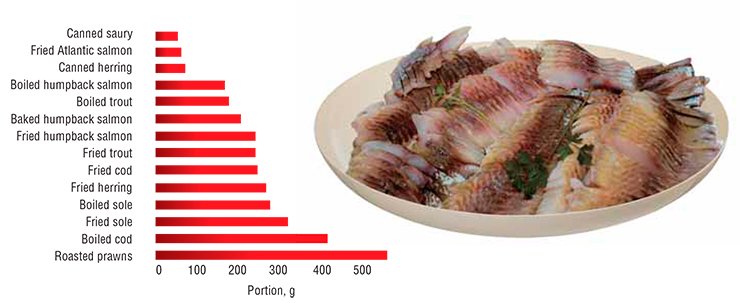
In our everyday life, we should not forget that the genotype of most people is initially programmed for a certain ratio of different polyunsaturated fatty acids in the consumed food, which provides a normal functioning of the cardiovascular and nervous systems as well as the other organs and tissues.
For prevention of the cardiovascular diseases, it is necessary to receive daily about 1 g of long-chain omega-3 PUFAs, the major source of which is fish and other seafood.
Noteworthy, most fish kinds available in shops are a valuable source of physiologically significant fatty acids, if they are cooked in a traditional manner. Note also that the WHO recommendations are in no way complicated or expensive—it is quite enough to daily eat 40 g of commonplace canned saury!
References
Gladyshev M. I. i dr. 2006. Biomanipulyatsiya «top-down» v nebol’shom sibirskom vodokhranilishche bez dafnii // Sib. Ekol. Zhurn. 13: 31—41.
Broadhurst C. L. et al. Brain-specific lipids from marine, lacustrine, or terrestrial food resources: potential impact on early African Homo sapiens // Compar. Biochem. Physiol. Part B. 2002. V. 131. Is. 4.P. 653—673.
Gladyshev M. I., Arts M. T., Sushchik N. N. Preliminary estimates of the export of omega-3 highly unsaturated fatty acids (EPA+DHA) from aquatic to terrestrial ecosystems. // Arts M. T. et al. (eds). Lipids in aquatic ecosystems. Springer, New York. P. 179—209.
The author thanks Academician I. I. Gitel’zon, candidate of biology E. E. Gladysheva, Academician Yu. Yu, Dgebuadze, Academician A. G. Degermendzhi, and doctor of biology N. N. Sushchik for their assistance in preparing the manuscript


